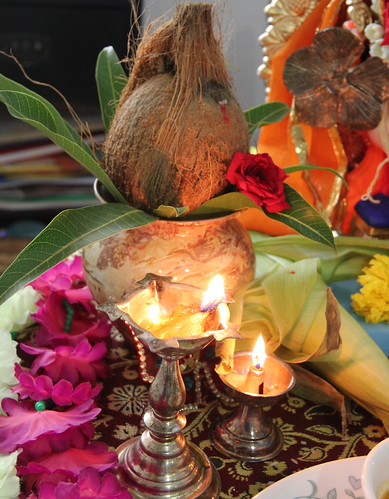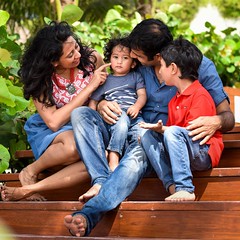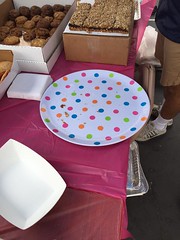Category Archives: Festivals
Happy Sankranti With Some Home-Made Halwyache Dagine
This is a repost of my post on Dying art of making halwyache dagine ( Or jewelry made out of sugar beads). Its traditional to make them during Sankranti festival. Read on to get a glimpse in this unique Indian tradition and then go on make some til-gul ladoos (ground sesame seeds ladoos)!
Halwa or sugar beads are made during Sankranti Festival. They are tiny white and orange/yellow colored sweet balls with tiny spikes on them.They are usually served along with til gul.
They also have another use – in making jewelry – called as Halwyache dagine or jewelry made of halwa. Per Maharashtrian custom, every newly wed couple is adorned in black clothes and halwa jewelry on the first Sankranti post marriage. There are a few folks who specialize in this jewelry but with modern times most folks don’t want to indulge in these activities and hence the art is declining.
My cousin who got married in April last celebrated her first Sankranti last weekend as a newly wed. Her mom ( as in my aunt) didn’t want to buy her a store-bought jewelry set. She had learnt the art of making these dagine when she was younger and was determined to make a unique set for my cousin. We are a family of DIY’ers 🙂
To give some context, the jewelry is made from the sugar beads. Its threaded together or glued on a flexible cardboard base. There is no ‘hole’ to thread the beads, so essentially you have to make the beads have enough ‘spikes’ so that when they are threaded between 4-5 strands of thread, they are held in place and don’t fall out.
And making the sugar beads is not easy. It has to be made by constantly stirring sugar syrup on a low heat around a central seed ( sesame seed, poppy seeds, sago, lentils or pumpkin seeds). The seed of choice is based on how small or large you want the sugar bead for the jewelry. Smaller ones are used for necklace strings and bangles while large ones are used in pendants, mang tikka etc. You can’t stir with a spoon as then you don’t have control on the spikes so you have to stir using your finger tips. Its tedious, laborious and of course cause blisters on finger tips due to constant stirring. But it results in a crisp halwa that is sweet and that stores for a long time.
It took my aunt more than a month to make the beads and then string them together. She was helped by her mom who was very excited to do this for her granddaughter. This is love personified. Very few people even know how to make this and even fewer practice it. I still recall the look of pride on their faces as we admired the hand made dagine during my visit to Mumbai. Doing this with full time job and managing a household is commendable!!
Few pictures of what they made- aren’t they gorgeous!
< Photos are taken by another professional which my cousin shared with me>
And my lovely cousin adorning them:
Hope you enjoyed this glimpse into unusual Indian traditions 🙂
Ganpati Bappa Morya!!
It was Ganesh Chaturthi on Monday…and we celebrated like every year.
Festive spirit, decorations, perfume of garlands and incense sticks and offerings of flowers, fruits and sweets marked the day.
In the evening we participated in prayers with rest of the folks in our complex.
For next 5 days, we will join them in evening prayers. The communal spirit, the decorations and festive atmosphere is novel and welcome change after the day at work.
A few pictures of Ganesh from our home….
Hope you enjoy this glimpse in our rituals as much as do!
Happy Fourth!

Wish all my American readers a very happy and safe Fourth of July!
Hope you spend the day with a BBQ, beer and enjoy fireworks!!
Image source – https://livinglargetinylot.wordpress.com/wp-content/uploads/2013/07/14b3e-winter-park-fourth-of-july.jpg
Holi Hai!
We had a fun day today with friends, colors, bhang and Biryani! We had DJ providing music, rounds of snacks and thandai and loads of colorful water being splashed.The kids loved spraying with water pistols and chasing each other. Not too many words, just a few pictures to capture the colorful occasion.
Hope you have a colorful, fun-filled Holi!
Dying Art of Hand Made Halwyache Dagine ( Jewelry made out of sugar beads)
Halwa or sugar beads are made during Sankranti Festival. They are tiny white and orange/yellow colored sweet balls with tiny spikes on them.They are usually served along with til gul.
They also have another use – in making jewelry – called as Halwyache dagine or jewelry made of halwa. Per Maharashtrian custom, every newly wed couple is adorned in black clothes and halwa jewelry on the first Sankranti post marriage. There are a few folks who specialize in this jewelry but with modern times most folks don’t want to indulge in these activities and hence the art is declining.
My cousin who got married in April last celebrated her first Sankranti last weekend as a newly wed. Her mom ( as in my aunt) didn’t want to buy her a store-bought jewelry set. She had learnt the art of making these dagine when she was younger and was determined to make a unique set for my cousin. We are a family of DIY’ers 🙂
To give some context, the jewelry is made from the sugar beads. Its threaded together or glued on a flexible cardboard base. There is no ‘hole’ to thread the beads, so essentially you have to make the beads have enough ‘spikes’ so that when they are threaded between 4-5 strands of thread, they are held in place and don’t fall out.
And making the sugar beads is not easy. It has to be made by constantly stirring sugar syrup on a low heat around a central seed ( sesame seed, poppy seeds, sago, lentils or pumpkin seeds). The seed of choice is based on how small or large you want the sugar bead for the jewelry. Smaller ones are used for necklace strings and bangles while large ones are used in pendants, mang tikka etc. You can’t stir with a spoon as then you don’t have control on the spikes so you have to stir using your finger tips. Its tedious, laborious and of course cause blisters on finger tips due to constant stirring. But it results in a crisp halwa that is sweet and that stores for a long time.
It took my aunt more than a month to make the beads and then string them together. She was helped by her mom who was very excited to do this for her granddaughter. This is love personified. Very few people even know how to make this and even fewer practice it. I still recall the look of pride on their faces as we admired the hand made dagine during my visit to Mumbai. Doing this with full time job and managing a household is commendable!!
Few pictures of what they made:
And my lovely cousin adorning them:
Hope you enjoyed this glimpse into unusual Indian traditions 🙂
Mom’s Til Kut Ladoos ( Ground Seasame seeds ladoos)
 Its Makar Sankranti on Monday. It marks the beginning of harvest season, longer days and transitioning out of cold winter days. In Maharashtra it is celebrated by exchanging til – gul ladoos ( sweets made out of seasame seeds and jaggery) both because they are warming foods in the cold winter days as well as because they are readily available ingredients at this time of the year.
Its Makar Sankranti on Monday. It marks the beginning of harvest season, longer days and transitioning out of cold winter days. In Maharashtra it is celebrated by exchanging til – gul ladoos ( sweets made out of seasame seeds and jaggery) both because they are warming foods in the cold winter days as well as because they are readily available ingredients at this time of the year.
Puran polis’ and halwa also make an appearance on the menu. Mom used to host a haldi kumkum in the evenings where she would invites her friends over and give them til gul halwa and a token gift. Dressed in black, the only time of the year where its ok to wear black on a festival, my brother and I would eagerly wait till all mom’s friends have left for the evening so we could eat those ladoos. In fact I love them so much that I volunteered to roll out ladoos this year after mom made the mix.

I am in Mumbai this year and helped make her traditional ladoos. Easy to make, they are healthy and perfect to snack on. The key to their success is in handling the jaggery correctly. It has to be softened on low to medium heat without letting it boil. If jaggery boils, it makes the ladoos chewy and stringy rather than the soft one you have in mind.
Mom’s Til Kut Ladoos Recipe:
Makes 40 – 45 lemon sized ladoos
- 1 pound seasame seeds
- 1 cup dessicated coconut or kopra grated
- 3/4 pound jaggery grated
- 3- 4 table spoons ghee or clarified butter
- 2 table spoons water
- 2 tea spoons, cardamom seeds coarsely crushed
1. Mom’s preps for these ladoos over a few days. First sesame seeds are cleaned, washed and dried. Then they are dry roasted till they are light pink and stored in an air tight container. Dry coconut or kopra is grated and then lightly roasted as well.
2. A day before making the ladoos, coarsely grind the seasame seeds.
3. Prepare the jaggery over low heat. Add ghee in a pan and keep it over low heat. Add grated jaggery. Add water and mix well. Take it off the heat and keep stirring to ensure that the melt doesn’t boil. This is the hard part so that the jaggery melts but is lump free as well.
4. Once ready, add the cardamom powder, coconut and til. Mix well.
5. Cool overnight or for couple of hours. Shape them into ladoos. Enjoy!



































